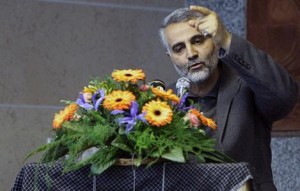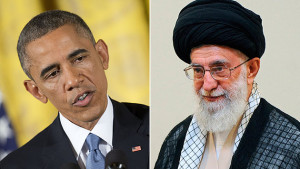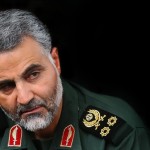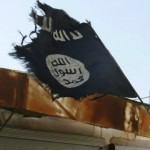by Farideh Farhi
Karl Sharro published this brilliant satire on the news coverage of the “shadowy” Iranian Qods Froce commander, Qassem Soleimani, almost a month before a big story appeared Nov. 5 in the Associated Press about the “mysterious” military “mastermind” who is apparently running the ground war in Iraq. Had he seen the AP’s piece, Sharro would have probably included its last juicy line about “Supermani” in his own article.
Sharro’s funny nickname for Soleimani doesn’t sound too unrealistic when you consider what’s being written about him. According to the AP, Soleimani—affectionately called Haj Qassem by many of his old and new fans in Iran (Wikipedia lists “shadowy commander” and “living martyr” as his two other nicknames)—is so fearless that he doesn’t wear a flak jacket in the front lines. He’s even able to convince Iraqi Shi’a militias—who apparently hadn’t heard of martyrdom prior to meeting Haj Qassem— that “death is the beginning of life, not the end of life.”

Major General Qasem Soleimani, the commander of the IRGC’s Qods Force, orates in front of flowers.
It’s difficult to imagine the source of that quote, an Iraqi “militia commander”—who, along with a bunch of other nameless Iraqi commanders and officials, seems to be the only source on Soleimani to the press—saying that line without chuckling a little afterwards. Yet those words seemed to echo throughout the world. The quote even made headlines in Tehran’s hard-line media, which ironically always relies on the foreign media—and statements from hawkish American commentators on Iran (John Bolton is a favorite)—to support its own positions. That’s because it confirmed Soleimani’s image in the minds of his Iranian admirers as embodying all the sublime elements of a devotee: he’s not only shy, soft-spoken, humble and modest in appearance—like Malik al-Ashtar, one of Imam Ali’s most loyal companions—but he’s also a fearless, seemingly unbeatable, military mastermind.
The image of Soleimani in the Western press has been seriously enhanced since 2008, when his role in brokering the cease-fire that restored calm in Basra in March 2008 was reported. Today the man is much more than just a “leading foreign policy strategist” and “person who plays a decisive role in Iran’s confrontation with the United States.” And the elevated depictions of him in the foreign press increasingly feed his public persona inside Iran.
In fact, with the rise of Islamic State (ISIS or IS), Soleimani has essentially become the icon through which to telegraph Iran’s would-be role in restoring order in Iraq and potentially the entire region. In other words, if Soleimani is indeed the man who has been “reshaping the Middle East,” then just a mere photo of him on the ground in Amerli should be good enough to circulate the message that accepting Iran’s regional role would bring strategic benefits for the US’s fight against extremism in Iraq. Of course, there have been many more photos of Soleimani in Iraq since then. And if that’s not enough, then more images and quotes from Iraqis about his—and by implication Iran’s—indispensable role will surely follow.
To be sure, there is also a domestic reason for celebrating what Soleimani reportedly represents, irrespective of whether he likes to play the part or not. At a time when Iranians are worried about regional instability and violence trickling into their own country, the emphasis on his unpretentious and yet competent presence in their defense and in opposition to regional extremism serves as assurance. Not to mention the fact that he’s now essentially a positive role model—a perfect counter to the argument that the Revolutionary Guards (IRGC) has become a rapacious economic corporation.
Yet it’s the message to the United States, in the midst of the currently sensitive negotiations with Iran over its nuclear program, which matters the most at this point. And it is a message that the White House apparently received if the reports of President Obama’s letter to Ayatollah Khamenei turn out to be true. Of course, at the time of writing this we have no official confirmation of the letter’s existence—Iranian officials are mum and the hard-line Kayhan newspaper has referred to it as “alleged” while describing the associated reporting as a psychological ploy to undermine the supreme leader. We also don’t have any details about the letter’s actual content, including whether it explicitly mentioned additional future cooperation between the two countries in the case of a nuclear accord.

US President Barack Obama and Iranian Supreme Leader Ayatollah Ali Khamenei
That said, I just don’t understand the rush to describe the letter—addressed to Soleimani’s commander-in-chief—as “spectacularly ill-conceived.” First of all, the fact that the existence of the letter—along with revelations about a possible US offer regarding centrifuges just a few days before—was leaked in the US could just as easily be interpreted as putting public pressure on Iran’s supreme leader and setting the stage for blaming him and Iran’s negotiating team if no deal is reached by the deadline of Nov. 24. Indeed, both Iran and the United States are positioning themselves to deflect blame if there is no deal. Note, for instance, what a senior official told the New York Times: “The larger obstacle to reaching an agreement on the uranium may be the Iranians… because what is less certain is whether Iran will accept the reasonable proposals on the table or will continue to make excessive demands that are not aligned with its practical nuclear needs.” The catch phrases of “excessive demands” and “reasonable proposals” are being used by the Iranians for their purposes as well.
Secondly, the essence of the knee-jerk objection to the letter sounds eerily similar to what used to be the dominant message on negotiating with Iran: it’s a stupid idea. We are told that the letter was ill-conceived because Khamenei is a Hobbesian who thinks the international system is unfair (a misunderstanding of Hobbes, I would say) and manipulated by bullies. Hence a letter from a presumed bully would be seen as “supplication” and “further confirmation of American desperation and weakness in the face of Iran’s position of advantage.” We are also assured that “the letter undoubtedly intensified Khamenei’s contempt for Washington and reinforced his longstanding determination to extract maximalist concessions from the international community.”
In other words, Khamenei is confined to the image of a dour old man with a Hobbesian worldview that cannot be swayed by talking to because he would see that as a sign of weakness and accordingly demand more concessions. Not long ago, the same logic was used to argue against talking to Iran period. Indeed, in this depiction of Khamenei, an emotional disposition (contempt) and a political demand or stance (extracting concessions, which any good negotiation involves) are commingled to delegitimize the Iranian negotiating team’s efforts to get the best deal it can—never mind the fact that the other side is doing the same thing. Lest we forget, those who are obsessed with the number of operating centrifuges in Iran seem oblivious to the concessions the international community would extract from Tehran if a deal is reached—concessions that reportedly include limits on the extent of uranium enrichment on Iranian soil, Iran’s shipment of its enriched uranium stock to another country, more intrusive inspections, the slow lifting of US sanctions, and more.
Again, these objections are really nothing new. The only unique development here is that the objection is directed at the presumed act of letter-writing—a negotiating tactic—rather than exclusively toward the act of directly negotiating with the Iranian “leadership.”
Furthermore, if Obama indeed sent a letter to Khamenei, calling the mere action a spectacular mistake is really only scratching the surface while venting. What about the actual content of the letter, which has not been revealed, but has been rejected as a harmful misstep anyway? Fortunately, we appear to have surpassed the time when finger wagging at anyone who dares to actually talk to Iran informs policy.
At this stage in the negotiations, it is only the leaders who are willing to make hard political choices—despite their treacherous domestic environments—who can make a mutually acceptable deal possible. Of course, direct contact between decision-makers doesn’t guarantee success in any negotiation. But in this case, the mere action has been written off as not only useless, but also harmful because Khamenei is yet again understood as a one-dimensional, sole power figure impervious to the complex politics and sentiments of his country with no sense of what is at stake and what he might lose or gain politically by agreeing to compromise.
I can’t help but notice how on par that portrayal is with all the embellished and politically motivated stories about Qassem Soleimani’s incredible and indelible prowess.






I seem to have missed something here? The article starts out on Gen Soleimani, then jumps to the supposed letter the “O” sent-maybe-to Khamenei, etc. Perhaps I need to go back to sleep again, then maybe I could get a fresh read that is different then what I’m left with now.
Some of the comments left on articles on this site are tremendously crappier than the content of the articles, which are almost always incredibly good (though I don’t agree with all the regular writers).
Despite the plague of Norman (whose name seems to appear in the comments section of every article here?) this is a brilliant piece of work. Congratulations to Farideh Farhi and Lobe Log.
Gosh GeofF, I thought that free speech was still alive and well here, regardless of what the content might be? Of course, those who have a Superiority Complex, always seem to come across as a troll.
Well, it seems that Iranians really do not need nuclear bombs when they have actually two Supermen: one is Ayatollah Khamenei and the other one is General fearless Qasem Soleimani. Let us hope Iran will not use this huge advantage over P5+1 group and do not make any “excessive demands” (like lifting of the sanctions) and make just “reasonable proposals” (like total surrender) to any “reasonable proposals” of Israel and P5+1 group.
The author seems confused in her deliberation. There is no need to use nearly 1450 word to write what can be said in one paragraph. I hope she can spend a little time cutting the fat for presenting the beef!